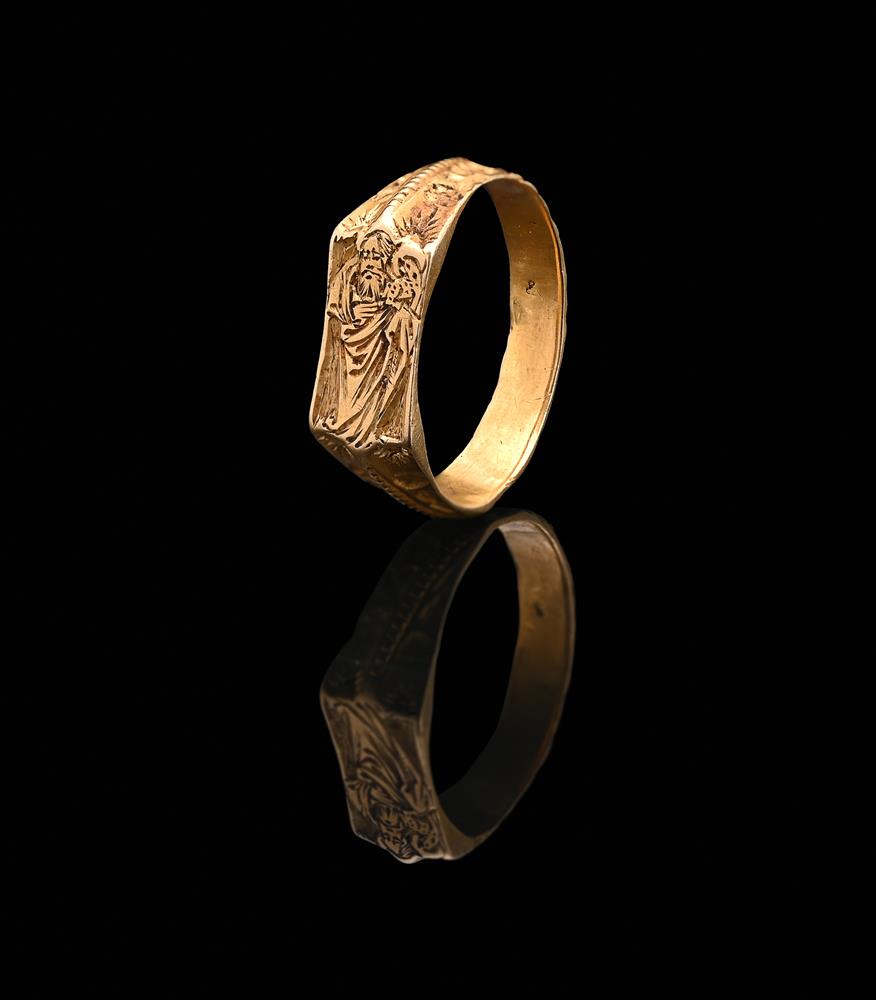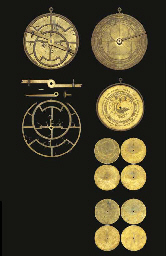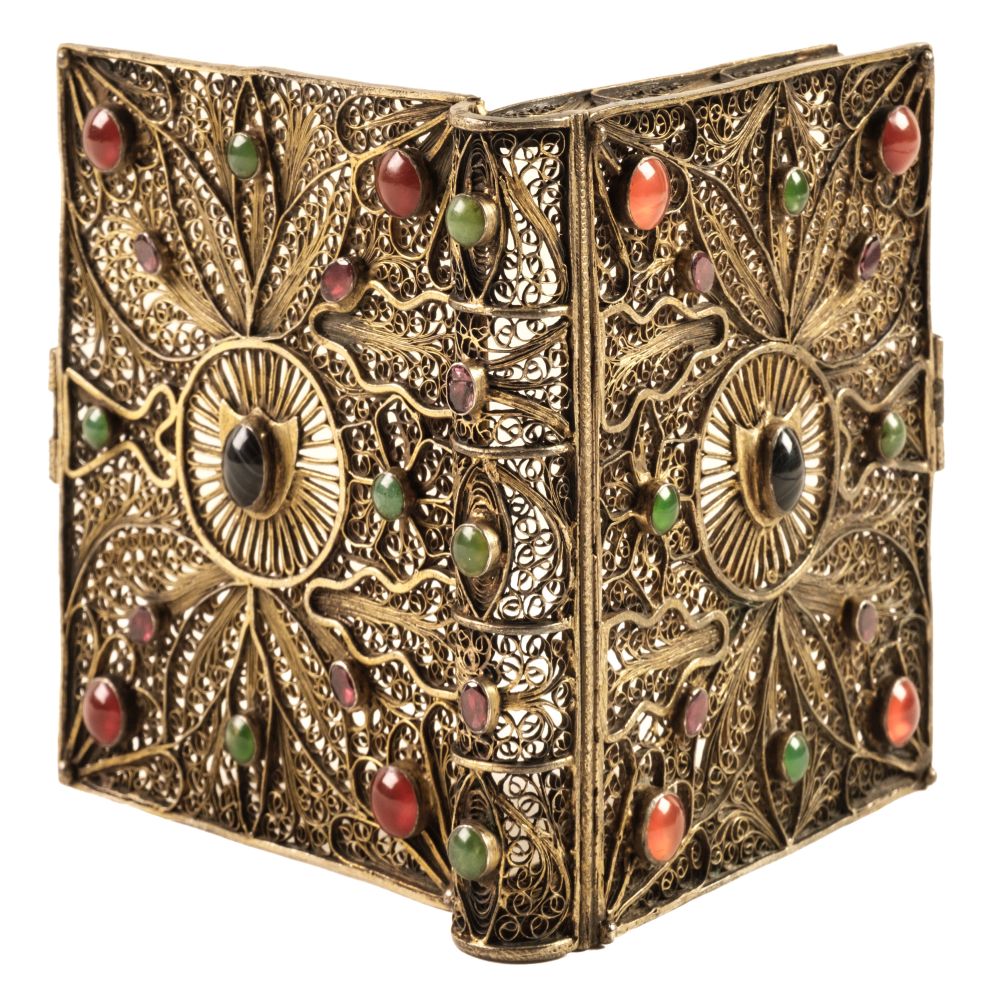° An early 15th century German manuscript volume of Lenten sermons, c1400. The volume consists of 134 foliated and three unfoliated paper leaves, 29 x 20cms. in a parchment binding, from which five metal bosses have been removed [1]. The text is written in two columns, and the four columns visible at each opening are identified with the lower-case letters a, b, c and d [2]. With the exception of folio 134, the text is rubricated, a process largely confined to initial capitals, biblical sources and the days of the week on which each sermon is to be delivered [3]. The watermark of an ox’s head surmounted by a flower [4] resembles Briquet 14743 [5, 6, 7], an example of which has been identified from a manuscript at Würzburg dated 1403.[1] The contents are as follows: Folios 1-30 Lenten sermons, signed Explicit per manus Heynrici Kothewicz Anno Domini Mo CCCCo primo 3a post Martini – completed by the hand of Heinrich Kothewicz in the year 1401 on the third [?Sunday] after St Martin [27 Nov 1401] [8]. 31 blank 32-115 Lenten sermons 116-133 Lenten sermons of Jacobus de Varagine, marked incomplete 134 (reversed) single leaf identified as de Sancto Vito unfoliated index, dated Anno Domini 1481 [9] The sequence of the volume’s creation begins with three unbound and unfoliated groups of sermons, represented by folios 1-133 and written within a decade of the element dated to 1401. In 1481, to enable the compilation of the index, foliation in Arabic numerals was applied to the recto of each leaf and the letters a, b, c and d to each column. It was probably at that date that the paper gatherings were bound into covers formed from wooden boards with a parchment cover. Folio 134 [10], which was mistakenly bound in reverse, probably dates from the time of the binding. The hand which added the folio numbers and the letters to each column inscribed column b of the opening folio liber sancti Petri in Erfordia C.l4 – the book of St Peter in Erfurt [number] 154 [11] At the same time the lower margin of the same folio was annotated Tria opera quadragesimalia quartum vero incompletum – three Lenten works, a fourth however incomplete [12] In the binding process two fragments of text were inserted as packing: 1.letter reciting a letter of John [von Fleckenstein], bishop of Worms, to his official concerning a dispute with the dean and chapter of the monastery of St Cyriac at Neuhausen, which can be dated to his episcopate of 1410-1426 [13] 2 Nine lines of rhyming couplets on the theme of hunting, probably a Minnesang Lied (German courtly love poem) [14] In the 19th century the left margin of the opening leaf was annotated in pencil 55m and 145, the significance of which is unclear, and the lower margin 133, representing the number of folios [2] In the 20th century the top-left corner of the opening leaf was annotated in pencil 1481 (the date of the index) and XI.bb (probably a shelf-mark). [1] CM Briquet, Les filigranes, dictionnaire historique des marques du papier dès leur apparition vers 1282 jusqu’en 1600; Amsterdam, The Paper Publication Society (Labarre Foundation), 1968. Remains of the Benedictine monastery dedicated to St Peter on the Petersberg, outside Erfurt in Thuringia are still extant. During the Thirty Years’ War Erfurt was occupied from 1631 by the troops of Gustav II Adolf of Sweden. The following year the monastery was dissolved, and briefly converted into a protestant monastery in 1633. The buildings were converted to secular use in 1803. Further damage took place in 1813 and 1814 and from 1820 the church was used as a store for flour and military provisions. Although nothing is known about the provenance of this manuscript, it seems likely that it left the monastery during one of these episodes of military activity. Gorringe’s would like to thank Christopher Whittick, former County Archivist for East Sussex, Drs Susanne Brand and Jens Röhrkasten, Professor of Medieval History in the Department of History at the University of Birming
° An early 15th century German manuscript volume of Lenten sermons, c1400. The volume consists of 134 foliated and three unfoliated paper leaves, 29 x 20cms. in a parchment binding, from which five metal bosses have been removed [1]. The text is written in two columns, and the four columns visible at each opening are identified with the lower-case letters a, b, c and d [2]. With the exception of folio 134, the text is rubricated, a process largely confined to initial capitals, biblical sources and the days of the week on which each sermon is to be delivered [3]. The watermark of an ox’s head surmounted by a flower [4] resembles Briquet 14743 [5, 6, 7], an example of which has been identified from a manuscript at Würzburg dated 1403.[1] The contents are as follows: Folios 1-30 Lenten sermons, signed Explicit per manus Heynrici Kothewicz Anno Domini Mo CCCCo primo 3a post Martini – completed by the hand of Heinrich Kothewicz in the year 1401 on the third [?Sunday] after St Martin [27 Nov 1401] [8]. 31 blank 32-115 Lenten sermons 116-133 Lenten sermons of Jacobus de Varagine, marked incomplete 134 (reversed) single leaf identified as de Sancto Vito unfoliated index, dated Anno Domini 1481 [9] The sequence of the volume’s creation begins with three unbound and unfoliated groups of sermons, represented by folios 1-133 and written within a decade of the element dated to 1401. In 1481, to enable the compilation of the index, foliation in Arabic numerals was applied to the recto of each leaf and the letters a, b, c and d to each column. It was probably at that date that the paper gatherings were bound into covers formed from wooden boards with a parchment cover. Folio 134 [10], which was mistakenly bound in reverse, probably dates from the time of the binding. The hand which added the folio numbers and the letters to each column inscribed column b of the opening folio liber sancti Petri in Erfordia C.l4 – the book of St Peter in Erfurt [number] 154 [11] At the same time the lower margin of the same folio was annotated Tria opera quadragesimalia quartum vero incompletum – three Lenten works, a fourth however incomplete [12] In the binding process two fragments of text were inserted as packing: 1.letter reciting a letter of John [von Fleckenstein], bishop of Worms, to his official concerning a dispute with the dean and chapter of the monastery of St Cyriac at Neuhausen, which can be dated to his episcopate of 1410-1426 [13] 2 Nine lines of rhyming couplets on the theme of hunting, probably a Minnesang Lied (German courtly love poem) [14] In the 19th century the left margin of the opening leaf was annotated in pencil 55m and 145, the significance of which is unclear, and the lower margin 133, representing the number of folios [2] In the 20th century the top-left corner of the opening leaf was annotated in pencil 1481 (the date of the index) and XI.bb (probably a shelf-mark). [1] CM Briquet, Les filigranes, dictionnaire historique des marques du papier dès leur apparition vers 1282 jusqu’en 1600; Amsterdam, The Paper Publication Society (Labarre Foundation), 1968. Remains of the Benedictine monastery dedicated to St Peter on the Petersberg, outside Erfurt in Thuringia are still extant. During the Thirty Years’ War Erfurt was occupied from 1631 by the troops of Gustav II Adolf of Sweden. The following year the monastery was dissolved, and briefly converted into a protestant monastery in 1633. The buildings were converted to secular use in 1803. Further damage took place in 1813 and 1814 and from 1820 the church was used as a store for flour and military provisions. Although nothing is known about the provenance of this manuscript, it seems likely that it left the monastery during one of these episodes of military activity. Gorringe’s would like to thank Christopher Whittick, former County Archivist for East Sussex, Drs Susanne Brand and Jens Röhrkasten, Professor of Medieval History in the Department of History at the University of Birming



.jpg?w=400)








.jpg)

Try LotSearch and its premium features for 7 days - without any costs!
Be notified automatically about new items in upcoming auctions.
Create an alert